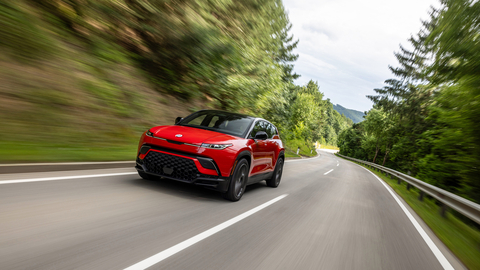Fisker to Release Ocean OS 2.0 Software Update, Improving Performance, SolarSky, Energy Management, and Other Features
- Ocean OS 2.0 is the first over-the-air (OTA) software update for 2024.
- Ocean OS 2.0 elevates the ownership experience with performance and powertrain improvements, enhancements for SolarSky, and improved energy management
- Fisker expects to continue frequent, progressive OTA software updates throughout 2024.

Fisker to Release Fisker Ocean Software Update V2.0, Improving Performance, SolarSky, Energy Management, and Other Features. (Photo: Business Wire)
The Ocean OS 2.0 OTA update includes performance and powertrain improvements, enhancements for SolarSky, improved energy management, and other user experience improvements. The update will be available to owners in all of Fisker’s launch markets in
“Our over-the-air software update strategy has shown the Fisker Ocean is a true connected car. Ocean OS 2.0 is a progressive update that demonstrates we can adapt and improve performance, energy management, and other key features in the Ocean,“ Chairman and CEO Henrik Fisker said. “We’ll continue to activate new features on a regular cadence, use driver feedback to fix software bugs and improve features, and keep delivering on the promise to make your Ocean smarter, more capable, and perform better over the lifetime of the vehicle.“
Ocean OS 2.0 contains the following updates:
New Features:
- Revised Front / Rear Torque split: In the Fisker Ocean’s dual-motor All-wheel Drive powertrain models (One, Extreme, and Ultra), the power distribution ratio between front and rear wheels is changed from 50:50 to 45:55. This update improves traction and handling performance, making the Ocean even more sporty and dynamic in both Fun and Hyper drive modes.
- Automatic Vehicle Hold: Automatic Vehicle Hold (AVH) replaces the Ocean’s existing Hill Hold feature, increasing vehicle hold time to improve driver ease and comfort. AVH activates brakes when the vehicle is stationary, and only releases brakes when the driver presses the accelerator pedal to begin moving the vehicle. This improvement was driven by customer feedback: the existing Hill Hold was designed to maintain brake pressure for approx. 2 seconds, and AVH now maintains brake pressure until driver is ready to move vehicle.
- SolarSky upgrade: On Extreme and One trims, a new SolarSky energy meter in the Charging/Energy menu on the Central Touchscreen shows how much solar charging is being delivered to the vehicle.
- Trailer Sway Mitigation: This stability control system feature counters trailer sway, making towing safer and more relaxed.
- Brake Disc Wiping: In wet weather, the braking system automatically and imperceptibly clears water from brake disc surfaces, to improve braking response.
- Standby Time controls: Standby Time controls on the Central Touchscreen allow drivers to adjust the amount of time the infotainment system stays in standby mode, reducing battery usage and increasing vehicle range. Drivers may experience longer vehicle boot-up time when Standby Time is reduced, in order to benefit from this reduced power consumption.
- Driver Profiles: Multiple drivers can save their preferences, privacy, and comfort settings in their own user profiles, including climate control and audio settings.
Performance improvements:
- Improved energy management and power retention
- Reduction in state of charge (SoC) loss while parked
- Calibration changes in cabin heating and cooling to improve defogging
- Improved heating/cooling performance in Earth Mode
- OTA updates able to be installed while vehicle is plugged in (note: charging pauses during software update).
- Revised audio tuning for improved bass response on Extreme/One
- Key fob performance enhancements, to improve response
- Improved accuracy in trip metering
- Improved accuracy in energy consumption metering
The company plans to continue its robust approach to software updates, using a staged roll-out plan to implement customer feedback from previous releases and to thoroughly test the OTA pipeline.
The Ocean Extreme has an EPA range of 360 mi 1, which is the longest range of any new electric SUV in its class in the US 2, and a WLTP range of 707 km /439
1 EPA estimated range. Mid-size SUVs. Measurements conducted with standard 20” wheels. Actual results may vary for many reasons, including driving conditions, wheel size, state of battery charge, and how the vehicle is driven and maintained.
2 Mid-size SUVs in comparable price segment.
3 This WLTP range number applies to Fisker’s European markets. WLTP measurements conducted with standard 20” wheels. Actual range will vary with conditions such as external environment, vehicle configuration, wheel size and vehicle use.
4 Based on Fisker simulations. Ideal conditions assume solar irradiation of 5.4 kWh/m2/day and steady commuter driving. Actual results vary with conditions such as external environment and vehicle use.
About Fisker Inc.
Download the revolutionary new Fisker mobile app from the App Store or Google Play .
Forward-Looking Statements
This press release includes forward-looking statements, which are subject to the "safe harbor" provisions of the US Private Securities Litigation Reform Act of 1995. These statements may be identified by words such as "feel," "believes," expects," "estimates," "projects," "intends," "should," "is to be," or the negative of such terms, or other comparable terminology and include, among other things, the quotation of our CEO, the statements regarding the planned launch timing, pricing, delivery, production, and estimated range of the Fisker Ocean, the planned timing of the opening of Fisker facilities, the Company's future performance, expansion of operations, software updates, and other future events that involve risks and uncertainties. Such forward-looking statements are not guarantees of future performance and are subject to risks and uncertainties, which could cause actual results to differ materially from the forward-looking statements contained herein due to many factors, including, but not limited to: Fisker's limited operating history; Fisker's ability to enter into additional manufacturing and other contracts with Magna or tier-one suppliers in order to execute on its business plan; the risk that OEM and supply partners do not meet agreed-upon timelines or experience capacity constraints; Fisker may experience significant delays in the design, manufacture, regulatory approval, launch and financing of its vehicles; Fisker's ability to execute its business model, including market acceptance of its planned products and services; Fisker's inability to retain key personnel and to hire additional personnel; competition in the electric vehicle market; Fisker's inability to develop a sales distribution network; and the ability to protect its intellectual property rights; and those factors discussed in Fisker's Annual Report on Form 10-K, under the heading "Risk Factors", filed with the Securities and Exchange Commission (the "SEC"), as supplemented by Quarterly Reports on Form 10-Q, and other reports and documents Fisker files from time to time with the SEC. Any forward-looking statements speak only as of the date on which they are made, and Fisker undertakes no obligation to update any forward-looking statement to reflect events or circumstances after the date of this press release.
View source version on businesswire.com: https://www.businesswire.com/news/home/20240206806730/en/
European Media:
Press.europe@fiskerinc.com
US Media
Fisker@GODRIVEN360.com
Customer service: Support@fiskerinc.com
Fisker Inc. Communications:
Matthew DeBord
VP, Communications
mdebord@fiskerinc.com
Franziska Queling
Regional Head of Public Relations Europe
fqueling@fiskerinc.com
Investor Relations:
Eric Goldstein
Head of Investor Relations
egoldstein@fiskerinc.com
Source: Fisker Inc.







